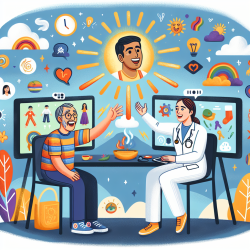In the ever-evolving field of speech-language pathology, practitioners must continuously seek evidence-based strategies to improve outcomes for their clients. One such innovative approach is highlighted in the research article "Online group music therapy: proactive management of undergraduate students’ stress and anxiety" by Finnerty, McWeeny, and Trainor. This study offers valuable insights into the efficacy of online group music therapy as a proactive intervention for reducing stress and anxiety in university students. Let's delve into the key findings and explore how practitioners can implement these outcomes to enhance their therapeutic practices.
Key Findings from the Research
The study was conducted during the COVID-19 pandemic, involving undergraduate students who participated in six weeks of weekly online therapy sessions. The students were divided into four groups: active group music therapy, receptive group music therapy, group verbal therapy (standard of care), and a no-intervention control group. The primary outcomes measured were stress and anxiety levels, assessed through self-report scales and physiological markers such as heart rate variability (HRV) and cortisol levels.
- Both active and receptive group music therapy significantly reduced stress and anxiety levels, comparable to the standard of care (verbal therapy).
- Short-term benefits were observed immediately after each 45-minute therapy session, with significant reductions in State-Trait Anxiety Inventory (STAI-S) and Likert stress scores.
- Long-term benefits included stable cortisol levels in therapy groups over the six-week period, contrasting with a significant increase in the control group.
Implementing Research Outcomes in Practice
Speech-language pathologists and other practitioners can leverage these findings to incorporate online group music therapy into their therapeutic repertoire. Here are some practical steps to get started:
1. Embrace Online Platforms
The success of online group music therapy in this study underscores the viability of remote therapy. Utilize platforms like Zoom or other telehealth services to conduct group sessions, ensuring accessibility for clients regardless of location.
2. Integrate Music Therapy Techniques
Depending on the group's needs, choose between active (e.g., songwriting, singing) and receptive (e.g., music listening) music therapy interventions. Tailor the sessions to encourage participation and engagement, fostering a supportive environment.
3. Monitor and Evaluate Outcomes
Implement self-report measures such as the STAI-S and Likert stress scales to assess immediate changes in stress and anxiety levels. Additionally, consider incorporating physiological markers like HRV and cortisol to gain a comprehensive understanding of the therapy's impact.
4. Foster a Proactive Approach
Encourage clients to engage in music therapy proactively, even if they do not have a clinical diagnosis. This can help manage stress and anxiety before they escalate, promoting overall well-being.
Encouraging Further Research
While the findings are promising, the study also highlights the need for further research with larger sample sizes and diverse populations. Practitioners are encouraged to contribute to this growing body of evidence by conducting their own studies and sharing outcomes with the broader community. To read the original research paper, please follow this link:
Online group music therapy: proactive management of undergraduate students’ stress and anxiety.










